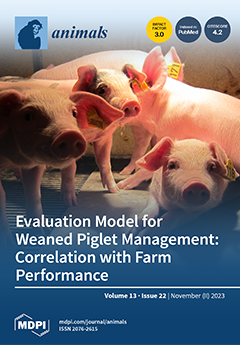The objective of this experiment was to investigate the effect of dietary supplementation with
Artemisia ordosica crude polysaccharide (AOCP) on growth performance, nutrient digestibility, antioxidant and immunity capacity, rumen fermentation parameters, and the microbiota of cashmere goats. A total of 12 cashmere goats
[...] Read more.
The objective of this experiment was to investigate the effect of dietary supplementation with
Artemisia ordosica crude polysaccharide (AOCP) on growth performance, nutrient digestibility, antioxidant and immunity capacity, rumen fermentation parameters, and the microbiota of cashmere goats. A total of 12 cashmere goats (2 years old) with similar weight (38.03 ± 2.42 kg of BW ± SD) were randomly divided into two dietary treatments with six replicates. The treatments were as follows: (1) control (CON, basal diet); and (2) AOCP treatment (AOCP, basal diet with 0.3% AOCP). Pre-feeding was conducted for 7 days, followed by an experimental period of 21 days. The results showed that the ADG; feed/gain (F/G); and the digestibility of DM, CP, and ADF of cashmere goats in the AOCP group were greater than in the CON group (
p < 0.05). Still, there was no significant effect on the digestibility of EE, NDF, Ca, and P (
p > 0.05). Compared to the CON group, AOCP increased BCP, propionate, butyrate, isobutyrate, valerate, isovalerate, and TVFA concentrations (
p < 0.05), but it reduced the protozoa numbers of acetate and A/P (
p < 0.05). The serum CAT, GSH-Px, T-SOD, 1L-6, and NO levels were higher in AOCP than in the CON group (
p < 0.05). The addition of AOCP increased the Sobs and Ace estimators (
p < 0.05) and reduced the Simpson estimator in the ruminal fluid compared to the CON group (
p < 0.05). Additionally, the AOCP group increased the colonization of beneficial bacteria by positively influencing GSH-Px and IL-6 (
norank_f__F082,
unclassified_p__Firmicutes), as well as bacteria negatively associated with F/G (
norank_f__norank_o__Bacteroidales,
unclassified_p__Firmicutes, and
norank_f__F082). It decreased the colonization of potential pathogenic bacteria (
Aeromonas and
Escherichia-Shigella) (
p < 0.05) compared to the CON group. In conclusion, 0.3% AOCP improves the growth performance, nutrient digestibility, antioxidant status, immune function, rumen fermentation, and microflora of cashmere goats.
Full article






